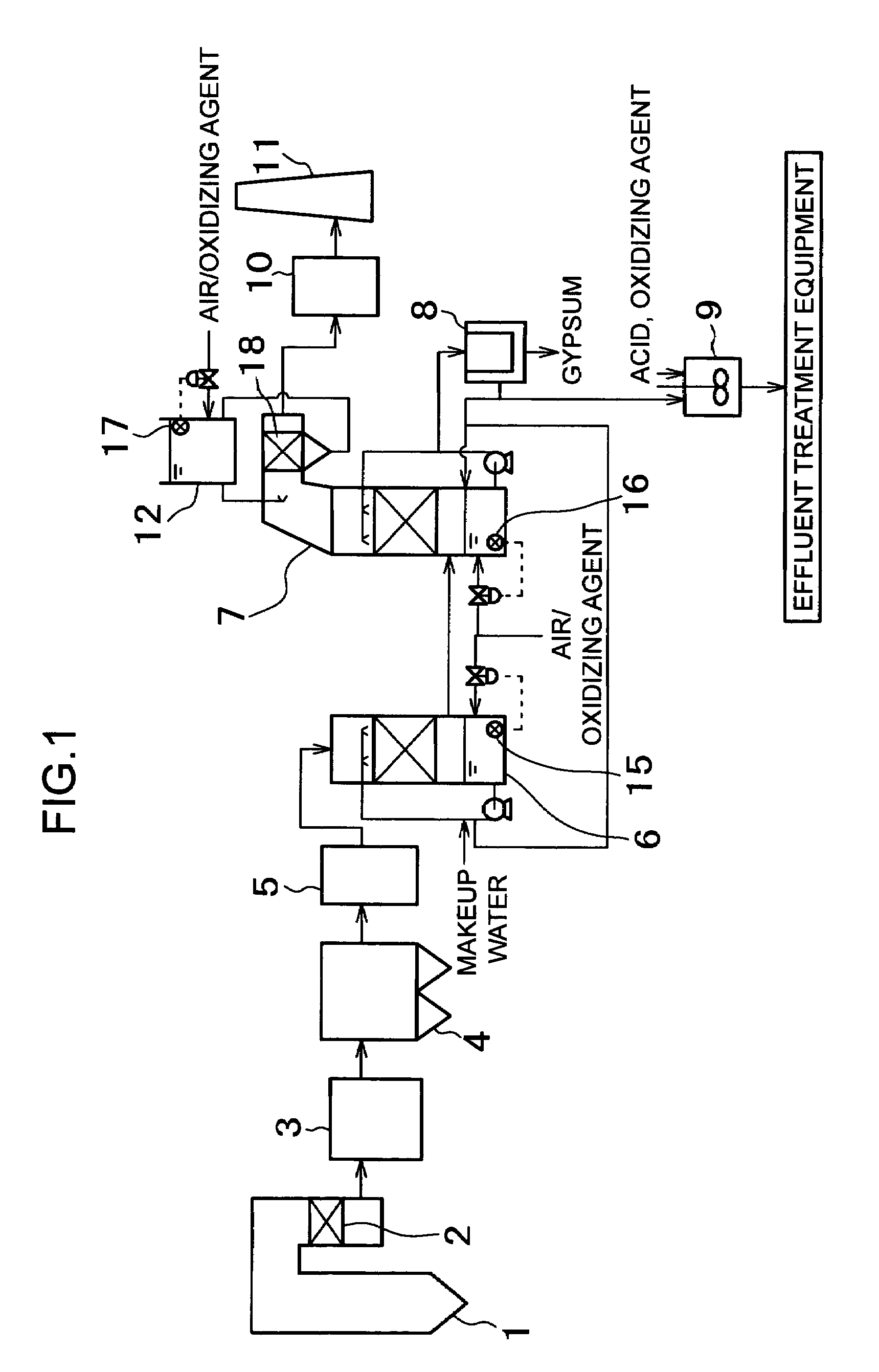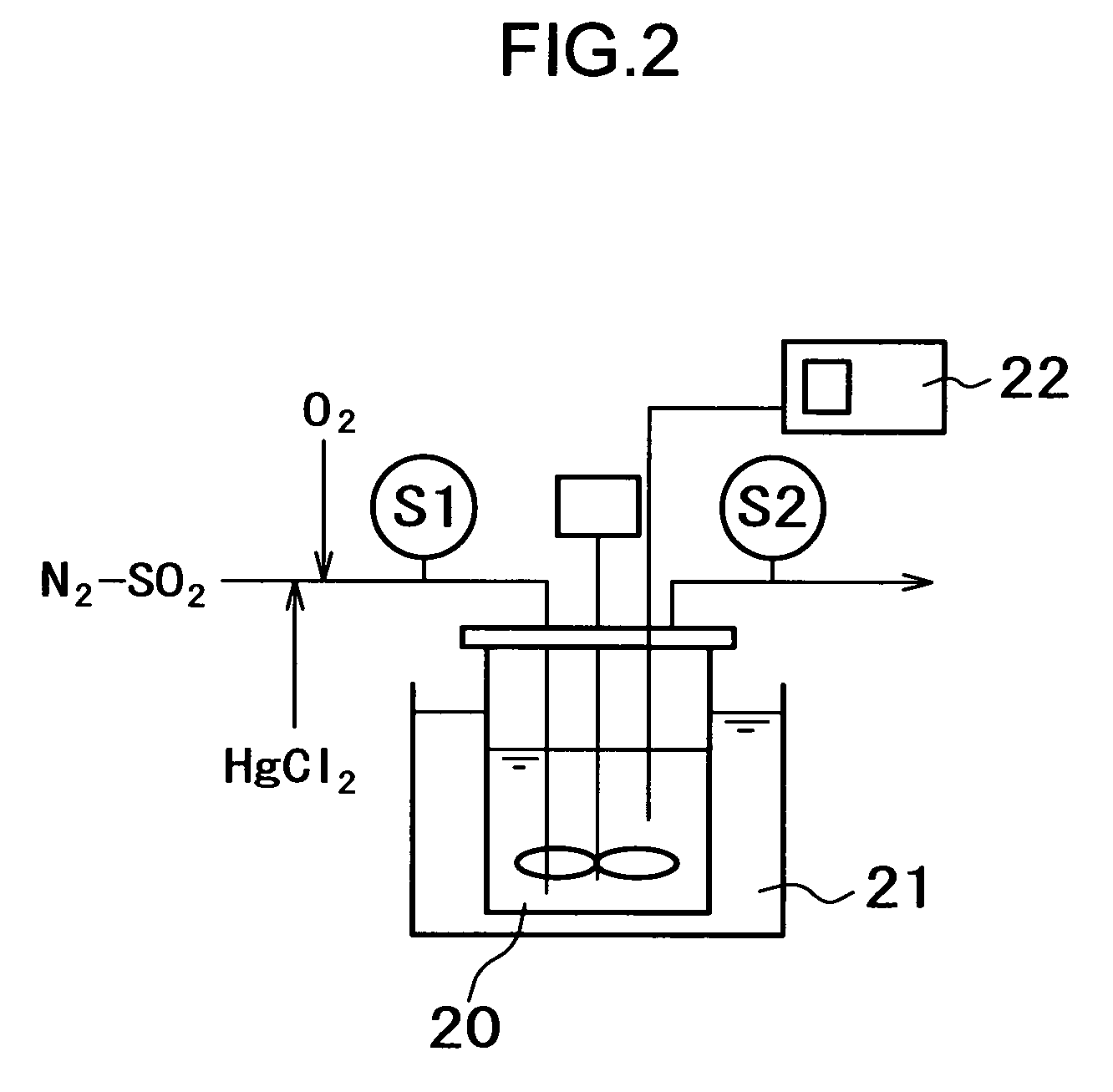Method for removing mercury in exhaust gas and system therefor
a technology of exhaust gas and mercury, applied in the direction of emission prevention, separation process, lighting and heating apparatus, etc., to achieve the effect of reducing cost, increasing the removal rate of mercury in exhaust gas, and absorbing and removing more surely
- Summary
- Abstract
- Description
- Claims
- Application Information
AI Technical Summary
Benefits of technology
Problems solved by technology
Method used
Image
Examples
example 1
[0067]A test was carried out by using a mercury absorbing test device shown in FIG. 2 to examine a condition in which mercury chloride is reduced by sulfur oxide (SO2).
[0068]In the device of example 1, O2 was added to N2 gas containing SO2, and mercury chloride (HgCl2) was mixed thereto, by which a simulation gas was prepared. The simulation gas was introduced into a reactor 20 whose temperature was controlled by a constant-temperature bath 21, and was stirred by a stirring blade provided in the reactor 20. For the solution in the reactor 20, the oxidation-reduction potential thereof was measured by an ORP meter 22. The gas in the reactor 20 was discharged from an outlet on top of the reactor 20. An inlet gas was sampled at S1, and an outlet gas at S2.
[0069]The test conditions were as described below: the contents of added components were O2: 4.0%, 10%, SO2: 1000 ppm, and HgCl2: 10 μg / m3N, the pressure was ordinary pressure, the reactor temperature was 60° C., the solution compositi...
example 2
[0072]A test for evaluating the mercury removal rate was carried out by using a system for removing mercury in exhaust gas shown in FIG. 3.
[0073]In the system of example 2, combustion equipment for burning pulverized coal together with air, an air heater (A / H) 3, an electric dust collector 4, a mercury oxidation catalyst 13 kept warm by an electric heater 14, a cooling tower 6, a desulfurization absorption tower 7, a heat exchanger (GGH) 10, and a stack 11 are arranged in that order. The cooling tower 6 is provided with an introduction pipe for blowing air, and the introduction pipe is provided with a valve for regulating the amount of blown air. An opening / closing mechanism of the valve is connected to an electrometer 15 for measuring the oxidation-reduction potential of an absorbing solution in the cooling tower 6. Similarly, the desulfurization absorption tower 7 is also provided with an introduction pipe provided with a valve, and an opening / closing mechanism of the valve is con...
example 3
[0079]A test for evaluating the mercury removal rate was carried out by using a system for removing mercury in exhaust gas shown in FIG. 4.
[0080]In the system of example 3, combustion equipment for burning pulverized coal together with air, an air heater (A / H) 3, an electric dust collector 4, a mercury oxidation catalyst 13 kept warm by an electric heater 14, a desulfurization absorption tower 7, a heat exchanger (GGH) 10, and a stack 11 are arranged in that order. At the lower part of the desulfurization absorption tower 7 is provided an introduction pipe for blowing air, and the introduction pipe is provided with a valve for regulating the amount of blown air. An opening / closing mechanism of the valve is connected to an electrometer 16 for measuring the oxidation-reduction potential of an absorbing solution.
[0081]In an exhaust gas flow path on the downstream of the desulfurization absorption tower 7, a gas-liquid contact section 18 is provided. In the gas-liquid contact section 18...
PUM
| Property | Measurement | Unit |
|---|---|---|
| Electric potential / voltage | aaaaa | aaaaa |
| Concentration | aaaaa | aaaaa |
Abstract
Description
Claims
Application Information
 Login to View More
Login to View More - R&D
- Intellectual Property
- Life Sciences
- Materials
- Tech Scout
- Unparalleled Data Quality
- Higher Quality Content
- 60% Fewer Hallucinations
Browse by: Latest US Patents, China's latest patents, Technical Efficacy Thesaurus, Application Domain, Technology Topic, Popular Technical Reports.
© 2025 PatSnap. All rights reserved.Legal|Privacy policy|Modern Slavery Act Transparency Statement|Sitemap|About US| Contact US: help@patsnap.com



